The Ultimate Guide to Solar Energy for Home in 2025
Many families worry about high power bills. In 2025, the average home spends over $125 each month on electricity. Prices keep going up every year. This makes it hard to save money.
Solar power is a smart fix for this problem. New home solar panels can cut your bill by up to 70%. Many people now get tax savings when they install panels. You can also earn by selling extra power back to the grid.

A small system can power lights and fans. A bigger system can run your whole house. Panels last over 25 years if you care for them well. Solar helps you save money and protect nature at the same time.
If you want to know complete details about the benefits of solar system then please visit Solar Energy Benefits.
What Is Solar Power and How Does It Work for Your Home?
Solar power is energy harnessed from the sun using solar panels. These panels contain special cells called photovoltaic (PV) cells, which capture sunlight and convert it into electricity. This electricity is then turned into usable power for your home by an inverter, which changes the electricity from direct current (DC) to alternating current (AC). By installing solar panels on your roof, you can reduce your electricity bills and rely less on the grid.
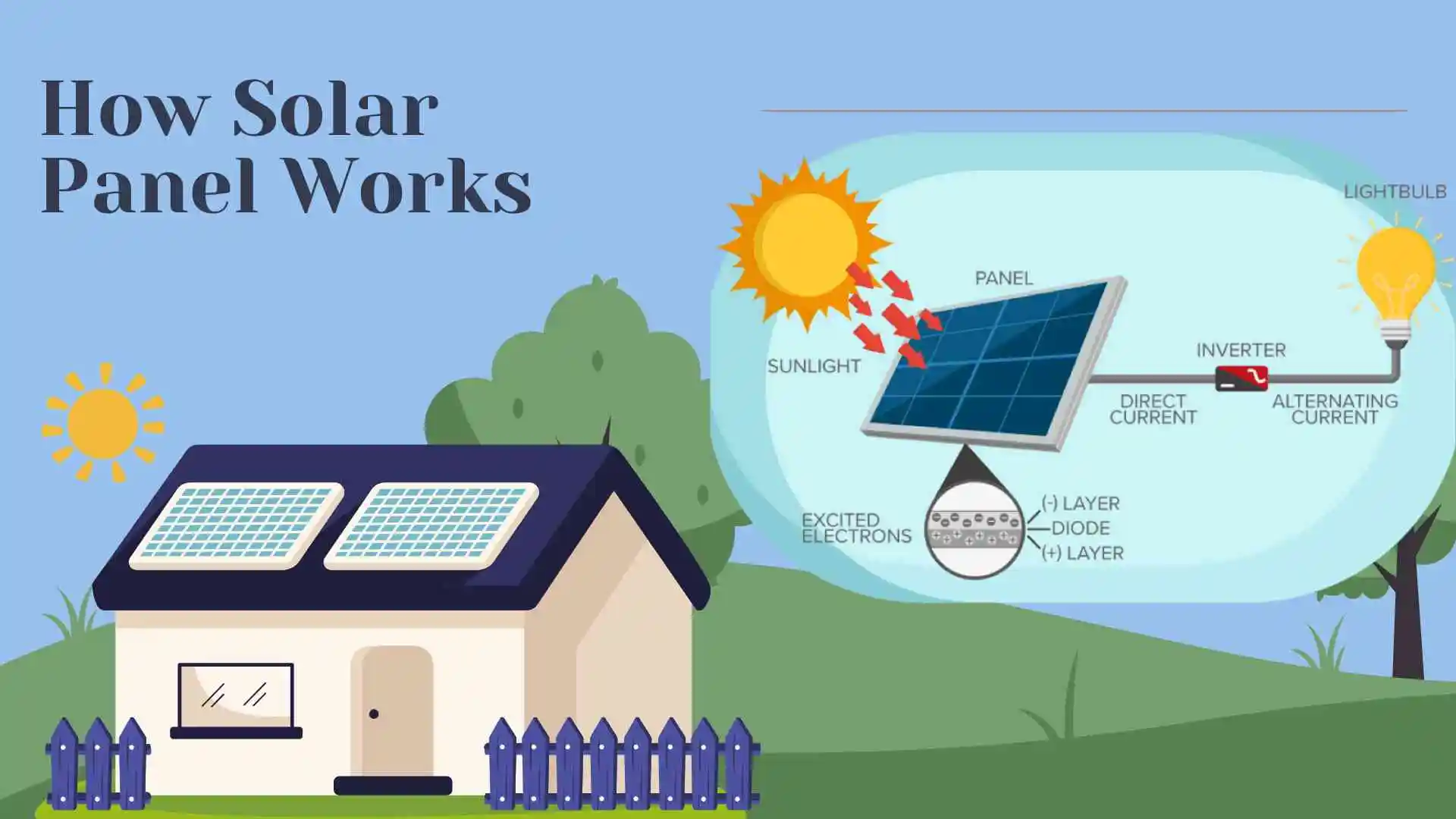
In 2025, solar technology has become more efficient and affordable. Innovations such as bifacial solar panels, which capture sunlight on both sides, are increasing energy production. Newer technologies like solar shingles are also gaining popularity because they integrate seamlessly into your home’s design. Solar power not only helps save money but also reduces your carbon footprint, making it a sustainable choice for homeowners.
How Solar Panels Harness the Sun’s Energy to Power Your Home
Solar panels capture sunlight using special cells known as photovoltaic (PV) cells. When sunlight hits these cells, they create an electric charge, which is then turned into electricity. This process is called the photovoltaic effect. The electricity generated is direct current (DC), but it’s then converted into alternating current (AC) by an inverter, which powers your home.
In 2025, solar panels are more efficient than ever before. They can now capture sunlight more effectively, even in cloudy or shaded areas. This increased efficiency means you can generate more power from less sunlight, making solar energy a reliable and cost-effective choice for homeowners. By using solar panels, you can reduce your electricity bills and contribute to a greener planet.
Understanding the Photovoltaic (PV) Effect – How Solar Panels Convert Light into Electricity
The photovoltaic (PV) effect is the process by which solar panels convert sunlight into electricity. When sunlight strikes the PV cells in a solar panel, it excites the electrons in the material, causing them to move. This movement creates an electric current. The energy from the sunlight is then captured and transformed into electricity that can power your home.
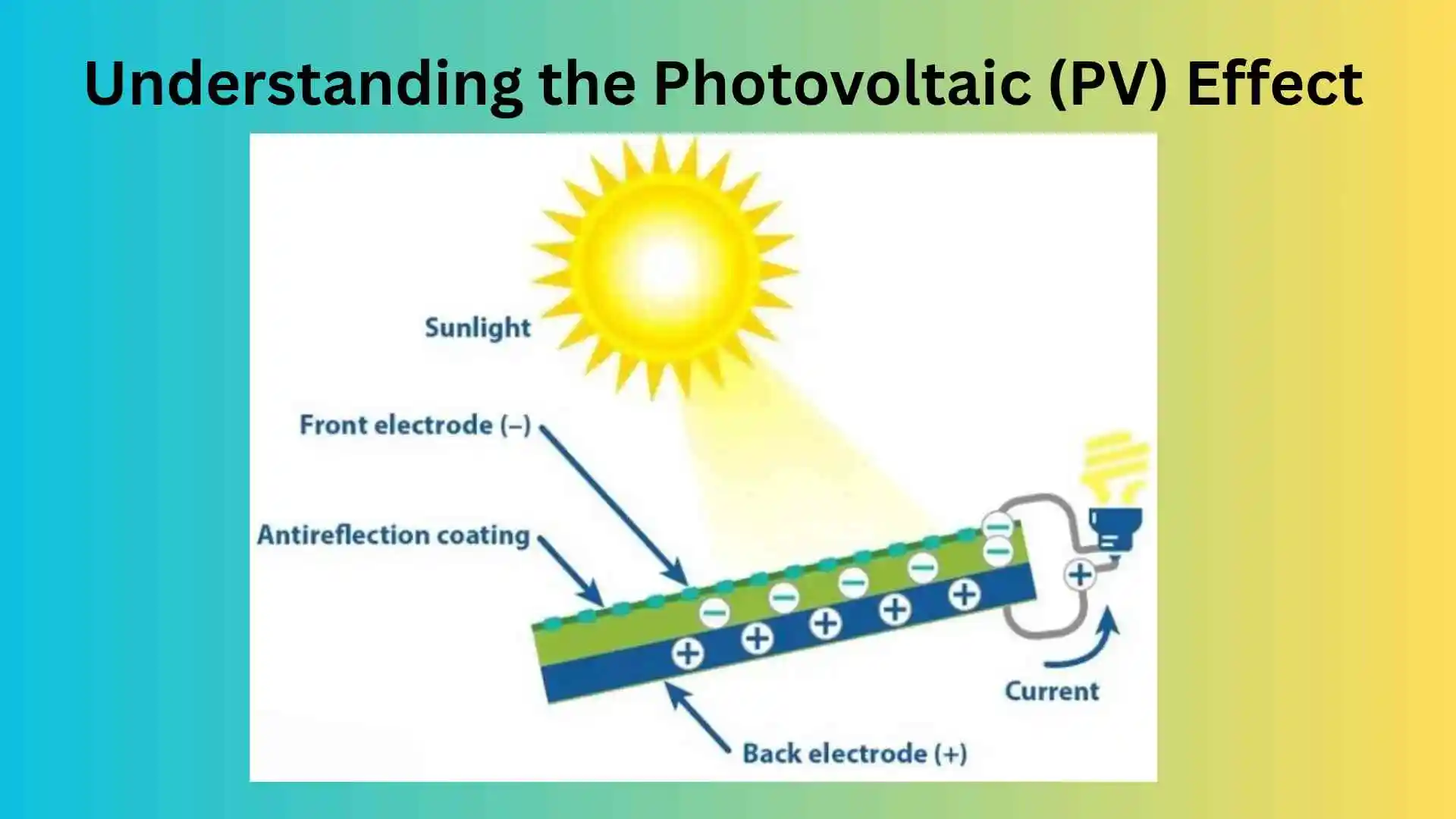
In 2025, PV technology has improved to capture more sunlight and generate higher energy efficiency. Modern solar panels use advanced materials, like silicon, to enhance this process. As a result, homeowners can now produce more electricity with fewer panels, even in areas with less sunlight. This makes solar power a more reliable and affordable energy solution.
How Does Sun Exposure Impact Solar Panel Efficiency?
Sun exposure is one of the most important factors affecting how much electricity solar panels can generate. The more sunlight the panels receive, the more energy they produce. Solar panels work best when placed in areas with direct sunlight for several hours each day, as this boosts their overall efficiency.
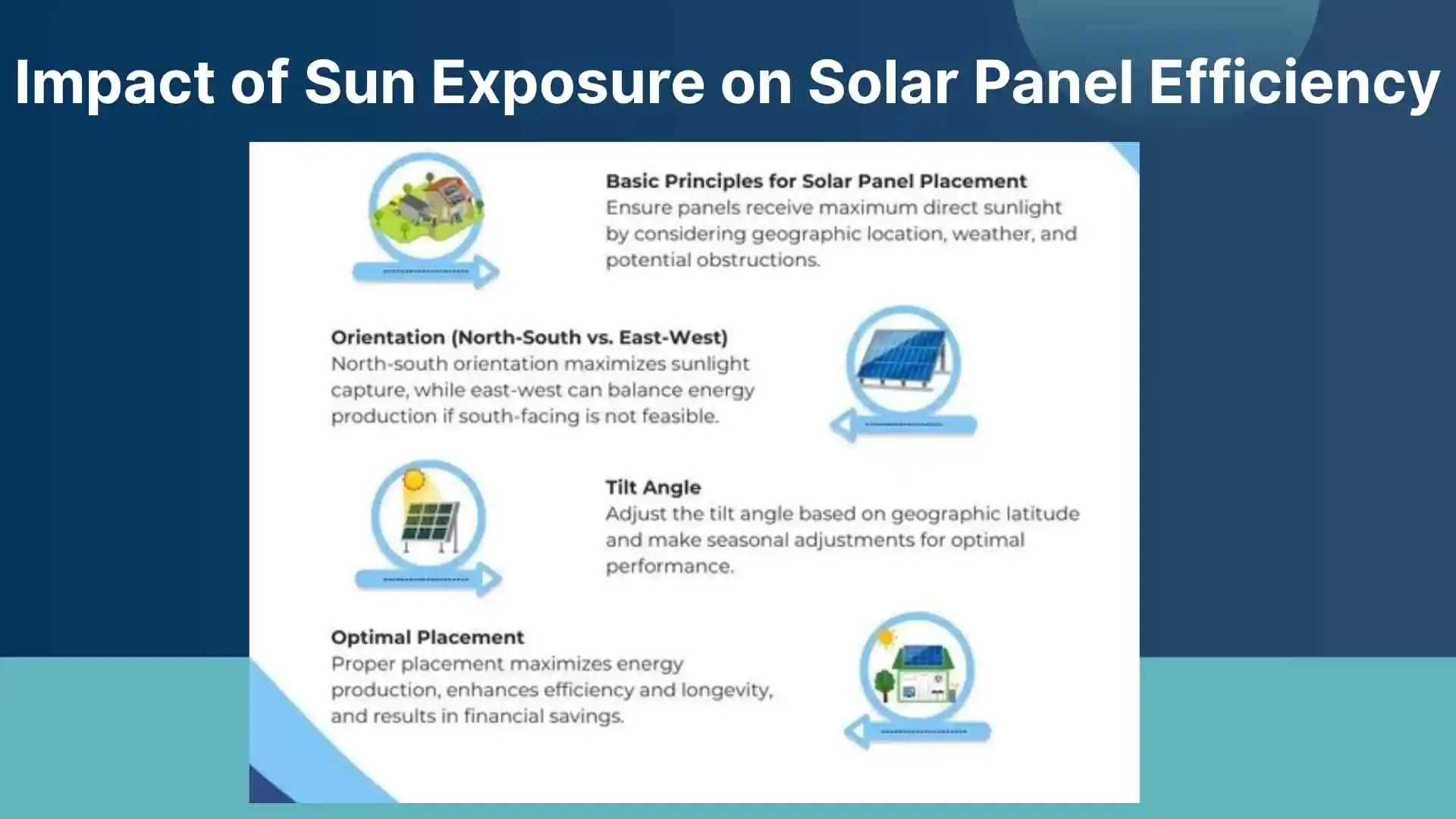
Solar technology has improved to ensure better performance in less sunny conditions. Some solar panels can now generate electricity even with partial sunlight or on cloudy days. While full sun exposure is still ideal, modern panels can still be effective in areas with variable sunlight, helping homeowners make the most of their solar systems year-round.
Key Components of a Solar Energy for Home – What You Need to Know
A home solar system consists of several key components that work together to harness the sun’s energy. The most important part is the solar panels, which capture sunlight and convert it into electricity. The energy generated is then sent to an inverter, which changes the electricity from direct current (DC) to alternating current (AC) so it can be used in your home.
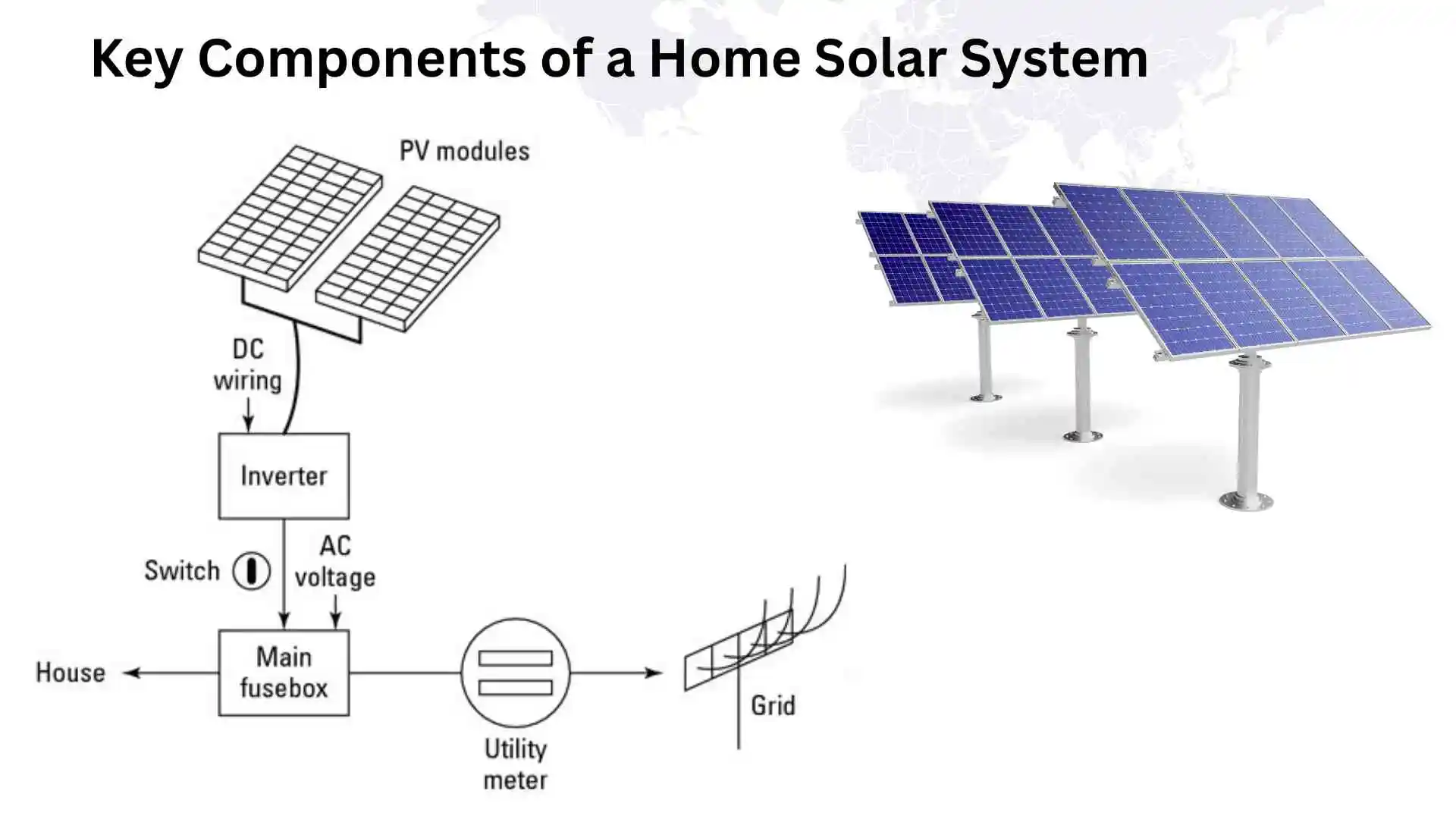
In addition to panels and inverters, many solar systems include batteries that store extra energy for later use. This is especially useful for cloudy days or during the night when your panels aren’t generating power. These components, along with the proper wiring and safety equipment, make up a complete solar power system that can provide reliable and renewable energy for your home.
Essential Solar Equipment – Panels, Inverters, and More

| Component | Function | Types/Considerations |
|---|---|---|
| Solar Panels | Capture sunlight and convert it into DC electricity. | Monocrystalline (High efficiency, longer lifespan, more expensive)- Polycrystalline (Affordable, slightly lower efficiency)- Thin-Film (Lightweight, lower efficiency) |
| Inverters | Convert DC electricity to AC electricity. | String Inverters (Multiple panels in series)- Microinverters (One inverter per panel)- Hybrid Inverters (Combine solar & battery systems) |
| Solar Batteries | Store excess energy for use during non-sunny times. | Lithium-ion (High efficiency, longer lifespan)- Lead-acid (Affordable, bulkier, shorter lifespan) |
| Charge Controller | Regulates voltage and current to prevent battery overcharging. | PWM (Pulse Width Modulation, less efficient)- MPPT (Maximum Power Point Tracking, more efficient) |
| Racking and Mounting Systems | Secure the solar panels in place (on rooftops, ground, etc.). | Fixed Mounts (Set angle)- Tracking Mounts (Panels follow the sun for more exposure) |
| Wiring and Electrical Components | Connects all system components for energy transmission. | Specialized cables for high voltage- Connectors for joining panels, inverter, and batteries |
| Energy Management System (EMS) | Monitors and controls the solar system’s performance and energy flow. | Integration with inverters and batteries- Real-time tracking and optimization features |
| Backup Generator | Provides additional power if solar system is insufficient (optional). | Sizing based on energy needs- Fuel type: Gas, Diesel, Propane |
| Grid Connection Equipment | Connects the system to the utility grid (for grid-tied systems). | Utility Meter (Tracks export/import energy)- Disconnect Switch (For maintenance or emergencies) |
| Monitoring System | Tracks solar system performance, energy production, and consumption. | Real-time tracking via app/web- Helps detect issues and optimize energy usage |
| Surge Protectors and Safety Equipment | Protects the system from power surges and ensures safe operation. | Surge protectors- Fuses, circuit breakers, grounding systems |
The Role of Batteries in Storing Solar Energy for Your Home
Batteries play a crucial role in a home solar system by storing excess energy for later use. During the day, when your solar panels produce more electricity than your home needs, the extra energy is stored in the battery. This stored energy can then be used at night or on cloudy days when the panels aren’t generating power.
Advances in battery technology have made them more efficient and affordable. Solar batteries help homeowners become less reliant on the grid, providing backup power during outages and ensuring a steady supply of energy. With these batteries, you can maximize the benefits of your solar system and enjoy greater energy independence.
How Do Home Solar Panels Work?
Home solar panels work by capturing sunlight and converting it into usable electricity. First, the solar panels’ photovoltaic (PV) cells absorb sunlight. This energy excites electrons in the cells, creating a flow of electricity, known as direct current (DC).
Next, the DC electricity is sent to an inverter, which changes it into alternating current (AC) electricity, the type of power used by most home appliances. If your system produces more energy than you need, the excess can be stored in a battery or sent back to the grid. This step-by-step process makes solar panels a reliable and efficient way to power your home with renewable energy.
Solar Panels and the Conversion Process – From Sunlight to Power for Your Appliances
Solar panels convert sunlight into electricity through a process called the photovoltaic (PV) effect. When sunlight hits the solar cells in the panels, it excites the electrons in the material, creating a flow of electricity. This electricity is direct current (DC), which is not directly usable by most household appliances.
To make this electricity usable, the DC power is sent to an inverter, which converts it into alternating current (AC) electricity. AC power is what powers your lights, appliances, and electronics at home. This conversion process ensures that solar energy can efficiently supply the electricity needed to run your household.
The Role of Inverters in a Solar Power System
Inverters play a key role in a solar power system by converting the electricity generated by the solar panels into usable power for your home. Solar panels produce direct current (DC) electricity, but most home appliances require alternating current (AC) electricity. The inverter takes the DC electricity from the panels and converts it into AC power that can be used by your lights, appliances, and electronics.
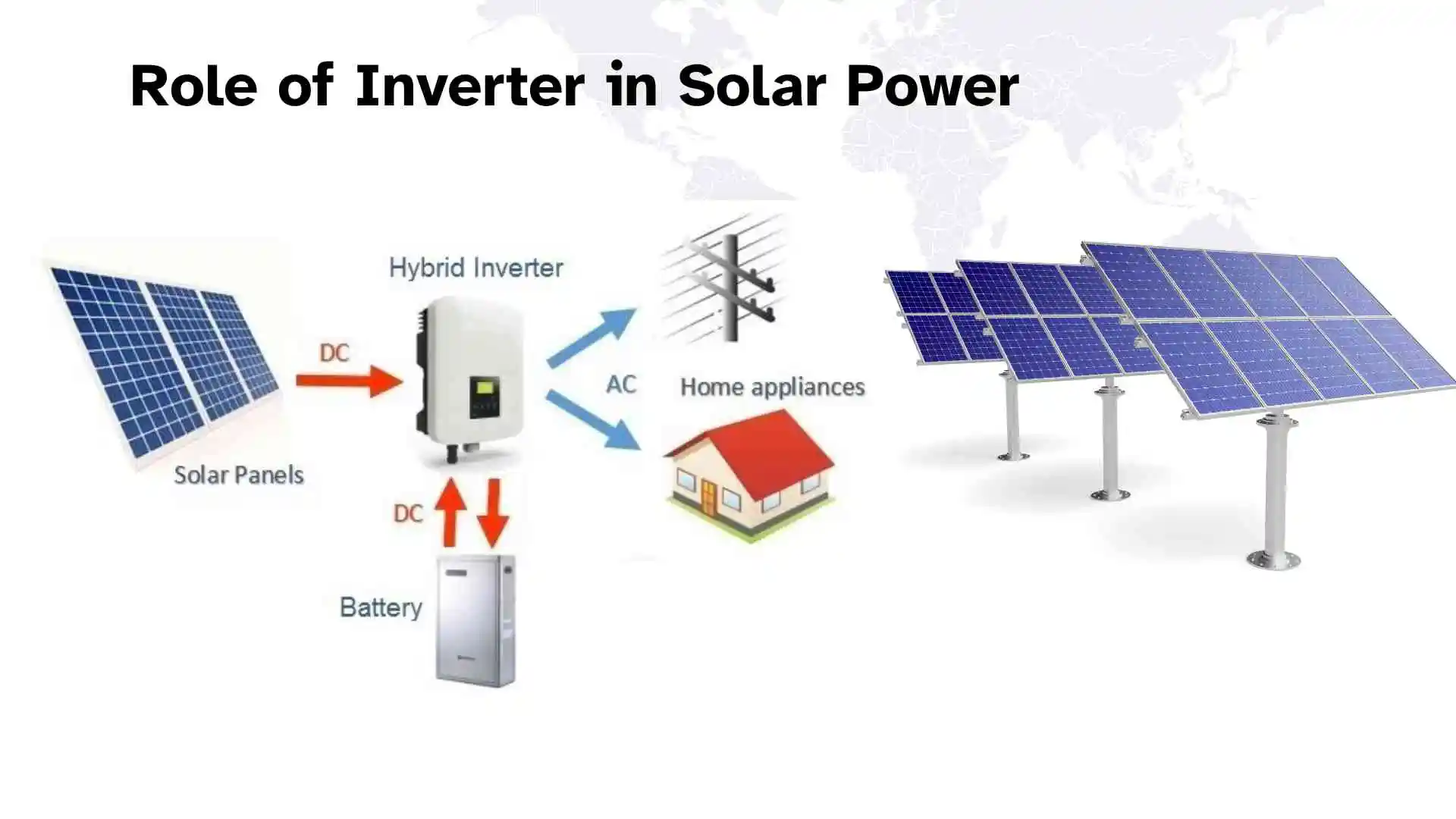
Inverters have become more efficient and advanced, with features like smart monitoring that help homeowners track energy production and consumption. Some inverters also allow you to store excess energy in batteries, giving you more control over your power use. Without inverters, solar panels wouldn’t be able to provide the electricity needed to run your home.
What Size Solar System Does Your Home Need?
The size of your solar system depends on several factors, including your energy needs, roof size, and local climate. To determine the right size, you’ll need to calculate how much electricity your household uses on average each month. A larger system is needed for bigger homes or households that consume more energy, while smaller homes may require fewer panels.
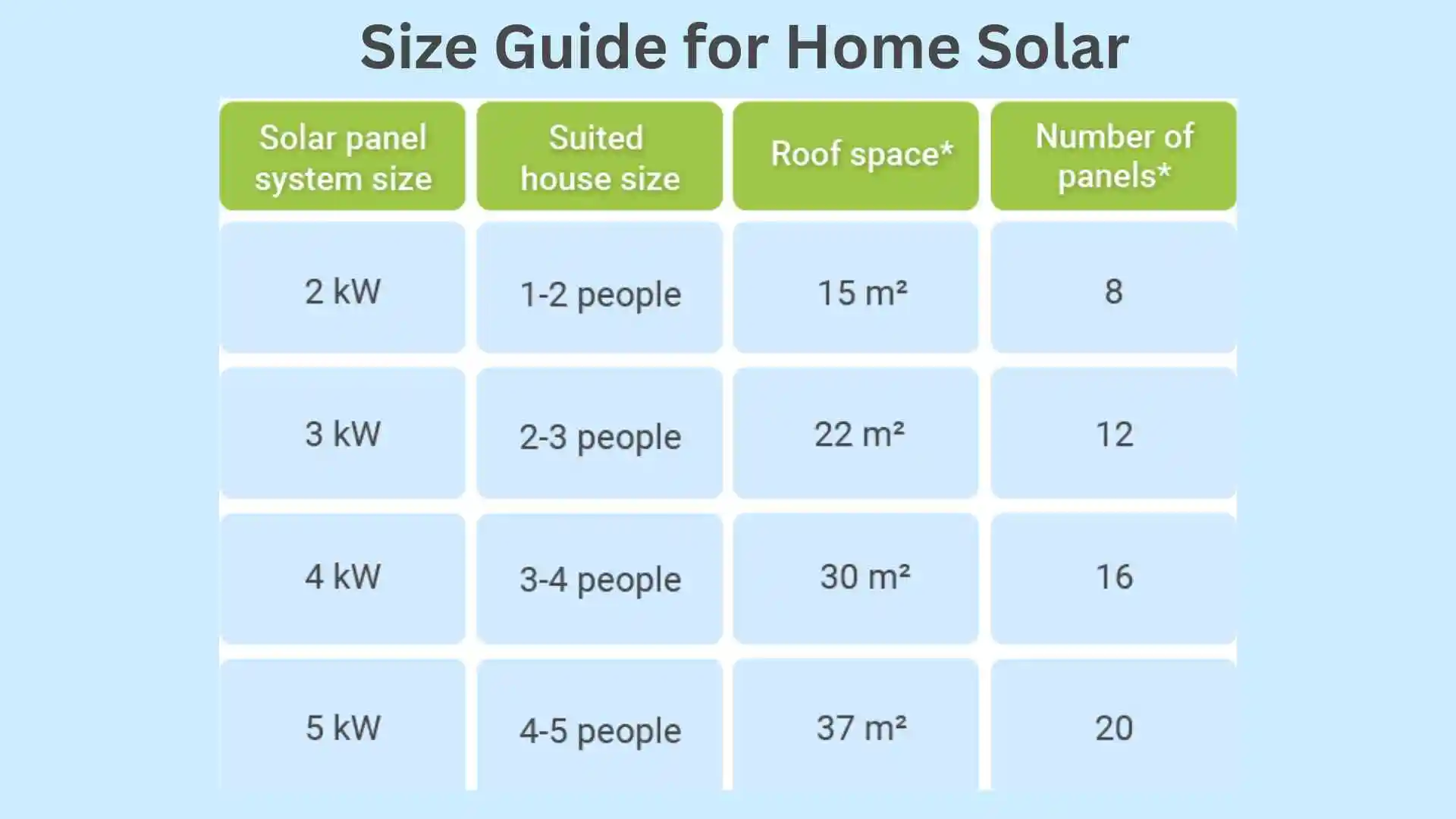
In 2025, solar technology allows for more flexibility in system sizing, and advances have made it easier to design systems tailored to specific needs. Solar professionals can help you assess your home’s energy usage and roof space, ensuring you install a system that meets your energy demands while maximizing efficiency.
Calculating the Right Solar Panel System Size for Your Household
To calculate the right solar panel system size for your home, start by looking at your average monthly electricity usage. This information can be found on your electric bill, typically measured in kilowatt-hours (kWh). Once you know your usage, you can estimate the number of solar panels needed by considering factors like panel efficiency, location, and available sunlight.
Solar technology has made this process easier with tools and professional services that can accurately calculate the ideal system size. By understanding your energy needs and working with experts, you can ensure that your solar system is the right size to cover your electricity consumption and make the most out of your investment.
| Factor | Description |
|---|---|
| Energy Consumption | Estimate your average monthly electricity usage to determine the system size. |
| Roof Size | Ensure enough roof space for the number of panels required. |
| Sunlight Exposure | Optimal sunlight exposure is essential for maximum energy production. |
How Much Roof Space Do You Need for Solar Panels?
The amount of roof space needed for solar panels depends on the size of your system and the type of panels you choose. On average, each solar panel requires about 15-20 square feet of space. To determine how much space you need, you’ll first need to calculate how many panels are required based on your energy consumption and the efficiency of the panels.
Solar panels have become more efficient, meaning fewer panels may be needed to produce the same amount of energy. If your roof space is limited, there are options like high-efficiency panels or solar shingles that can help maximize the available space while still meeting your energy needs.
Understanding the Pros and Cons of Solar Panels for Your Home
Solar panels offer several benefits for homeowners, such as reducing electricity bills and lowering your carbon footprint. By generating your own energy, you become less reliant on the grid, which can lead to long-term savings. Additionally, solar energy is a renewable resource, meaning it helps preserve the environment by reducing greenhouse gas emissions.

However, there are some drawbacks to consider. The initial installation cost of solar panels can be high, though prices have dropped in recent years. Additionally, solar panels depend on sunlight, so their efficiency can be reduced on cloudy days or during the winter months. Despite these challenges, many homeowners find that the benefits outweigh the cons, especially with improved technology and available incentives.
Key Advantages of Solar Panels – Saving Money and Reducing Carbon Footprint
One of the biggest advantages of solar panels is the potential for significant savings on your electricity bills. By generating your own power, you reduce the amount of electricity you need to buy from the grid. Over time, these savings can offset the initial installation cost, and many homeowners see long-term financial benefits.
Solar panels also help reduce your carbon footprint, as they produce clean, renewable energy. Unlike fossil fuels, solar power doesn’t release harmful emissions into the atmosphere. This makes it an environmentally friendly choice, contributing to the fight against climate change while helping you live more sustainably.
Potential Disadvantages – Installation Costs, Maintenance, and Weather Dependency
While solar panels offer long-term savings, the initial installation cost can be a significant barrier for many homeowners. The cost of purchasing and installing panels, inverters, and other necessary equipment can be high, although incentives and tax credits may help reduce this burden. Additionally, maintaining solar panels requires occasional cleaning and inspections to ensure they continue to function efficiently.
Another disadvantage is that solar panels are dependent on sunlight to generate power, which means their efficiency can be affected by weather conditions. On cloudy or rainy days, your panels may produce less energy, and their performance may be lower in winter months when the days are shorter. However, modern solar systems are designed to work even in less-than-ideal conditions, though backup energy sources may still be needed.
Costs, Savings, and Financing – Is Solar Energy Worth It?
The cost of installing solar panels has dropped in recent years, but it can still be a big investment. On average, homeowners can expect to pay anywhere from $10,000 to $30,000 for a full solar system. However, with available tax incentives, rebates, and falling prices, this initial cost is becoming more manageable.
Over time, solar panels can save you a lot of money by lowering your electricity bills. Many homeowners see a return on their investment within 6 to 10 years. Additionally, financing options like loans, leases, and power purchase agreements (PPAs) make it easier to install solar without paying everything upfront. With the right financing, you can start saving money while paying off the system gradually.
| Aspect | Description |
|---|---|
| Initial Installation Cost | Average cost of installing solar panels can range from $10,000 to $30,000. |
| Savings Over Time | Solar panels can save 70% or more on electricity bills, with long-term savings. |
| Financing Options | Options include solar loans, leases, and power purchase agreements (PPAs). |
| Return on Investment | Typically, solar panels pay for themselves in 6 to 10 years. |
The Average Cost of Installing Solar Panels in 2025
The average cost to install a solar panel system for a home ranges between $25,000 and $45,000 before incentives. This cost includes the panels, inverter, installation, and other necessary equipment. However, the final price can vary depending on factors like the size of the system and where you live.
After applying the federal solar tax credit, which is around 30%, the cost can drop to approximately $17,500 to $31,500. Additionally, some states and local utilities offer extra incentives that can lower the price even more. On average, the cost per watt for solar installations in 2025 is about $2.90, with a typical 6-kilowatt system costing around $17,400 before any credits.
How Much Can You Save with Solar Energy Over Time?
Switching to solar energy can help you save a significant amount on your electricity bills. On average, homeowners can save between $10,000 and $30,000 over 20 years, depending on their energy usage and local electricity rates. As solar panels typically last for 25 to 30 years, these long-term savings can make your initial investment worthwhile.
Solar technology is more efficient, meaning you can generate more energy with fewer panels, which can lead to even greater savings. Additionally, many homeowners see increased property values due to their solar installations, adding further financial benefits. Over time, as your system pays for itself, the savings from solar energy will continue to grow, making it a smart choice for reducing long-term energy costs.
Financing Options for Solar Installations – Loans, Incentives, and Leasing
Homeowners have several financing options to make solar installations more affordable. These include loans, leasing, and power purchase agreements (PPAs), each with its own benefits and considerations.
Solar Loans
Solar loans allow homeowners to borrow money to purchase a solar system, which they repay over time. These loans often come with lower interest rates compared to traditional loans and may offer terms ranging from 5 to 25 years. By owning the system, homeowners can take advantage of the 30% federal solar tax credit and potentially increase their property value. However, it’s important to consider the total cost, including interest, and ensure the monthly payments fit within your budget.
Leasing and Power Purchase Agreements (PPAs)
Leasing and PPAs are alternatives where homeowners pay a fixed monthly fee to use the solar system or pay for the electricity generated, respectively. These options typically require little to no upfront cost and include maintenance. However, the homeowner does not own the system and may not be eligible for tax credits. Additionally, savings can be less compared to ownership, and the agreements can last 20–25 years.
Tax Incentives and Rebates
The federal government offers a 30% tax credit for solar installations, reducing the overall cost. Many states and local utilities also provide additional rebates and incentives to further lower expenses. It’s advisable to research available programs in your area to maximize savings.
Property Assessed Clean Energy (PACE) Financing
In some regions, PACE financing allows homeowners to finance solar installations through property taxes. Repayments are made via property tax assessments over a period of up to 20 years. This option may be available even for those with less-than-perfect credit, but it’s essential to understand the implications, as the assessment stays with the property if sold.
Are Solar Panels a Good Investment? Financial Returns Explained
Solar panels can be a great investment, offering both financial and environmental benefits. While the initial cost may seem high, solar systems typically pay for themselves within 6 to 10 years through energy savings. In 2025, as solar technology improves and costs decrease, many homeowners see even faster returns. By generating your own electricity, you can lower or even eliminate your monthly power bills, resulting in long-term savings.
Additionally, solar panels can increase the value of your home, making it a smart financial move if you plan to sell in the future. Many buyers are attracted to homes with solar installations due to the promise of lower energy costs. With tax credits, rebates, and financing options, solar panels offer a solid return on investment, making them a worthwhile consideration for homeowners.
Do Solar Panels Increase Your Home’s Value?
Yes, installing solar panels can increase your home’s value. In 2025, homes with solar panels sold for an average of 6.9% more than comparable homes without them. This translates to approximately $25,000 to $29,000 more for a median-priced home.
The value added depends on factors like system size, location, and energy savings. For instance, in high electricity cost areas, buyers may value the long-term savings more, leading to a higher premium. Additionally, homes with owned solar systems tend to fetch higher prices than those with leased systems.
How Solar Panels Can Boost Your Property’s Resale Value
Solar panels can significantly increase the resale value of your home. Studies show that homes with solar systems tend to sell for more than similar homes without them. On average, a solar-equipped home can increase in value by about 4% to 6%, which can translate to tens of thousands of dollars, depending on your home’s location and market conditions.
In addition to higher sale prices, solar panels appeal to buyers who are looking for long-term savings on energy bills. Homes with solar panels are seen as more energy-efficient and environmentally friendly, making them attractive to eco-conscious buyers. With the growing popularity of renewable energy, having solar panels can make your home stand out in the real estate market and help you sell faster.
| Factor | Description |
|---|---|
| Resale Value | Homes with solar panels tend to sell for 4% to 6% more on average. |
| Market Appeal | Solar panels make homes more attractive to buyers looking for energy savings. |
The Impact of Solar Panels on Your Home’s Marketability
Solar panels can greatly improve your home’s marketability by making it more attractive to a broader pool of buyers. As energy costs rise, many homebuyers are looking for ways to reduce their future electricity bills, and a solar-powered home provides a solution. Homes with solar panels are often seen as more modern, energy-efficient, and environmentally friendly, which can help your property stand out in a competitive real estate market.
In addition, the growing awareness of climate change and the benefits of renewable energy makes homes with solar installations more desirable. Buyers may be willing to pay a premium for homes that come with solar panels, knowing they’ll save money in the long run. As a result, solar panels not only increase your home’s value but also make it more marketable and appealing to potential buyers.
Is Your Home Suitable for Solar Panels?
To determine if your home is suitable for solar panels, you’ll need to consider factors like roof size, orientation, and sunlight exposure. Solar panels work best on roofs that receive direct sunlight for most of the day, so a roof facing south is ideal. You should also check if your roof is in good condition, as solar panels can last for 25 to 30 years, and it’s best to replace the roof before installing panels if needed.
Additionally, the amount of shade on your roof can impact the efficiency of your solar system. If trees or nearby buildings block sunlight for a significant part of the day, your panels may produce less energy. It’s important to have a professional solar installer assess your home to ensure that it can support a solar system and meet your energy needs.
| Factor | Description |
|---|---|
| Roof Condition | Roof should be in good condition and able to support solar panels. |
| Roof Orientation | South-facing roofs are ideal for solar panels to capture the most sunlight. |
| Shading | Ensure that there is minimal shading from trees or nearby buildings. |
| Energy Needs | Assess your home’s energy needs to determine the required solar system size. |
Key Factors to Determine If Solar Is Right for Your Home – Roof Size, Location, and More
Several factors help determine if solar panels are a good fit for your home. The first is roof size—you’ll need enough space for the panels to capture enough sunlight to meet your energy needs. Ideally, your roof should be clear of obstructions like chimneys or trees that could block the sunlight.
Location plays a significant role as well. Homes in areas with strong sunlight, like southern-facing roofs, are best suited for solar energy. Additionally, roof condition is important; if your roof needs repairs or replacement soon, it’s best to take care of that before installing solar panels. By considering these key factors, you can make an informed decision about whether solar power is the right choice for your home.
How to Assess Your Home’s Solar Potential
To assess your home’s solar potential, start by evaluating the amount of sunlight your roof receives throughout the day. A solar installer can conduct a solar site survey, which uses tools to measure the sunlight exposure and determine how much energy your roof can generate. Homes with roofs that face south or southwest typically get the best sunlight, making them ideal for solar installations.
Next, check your roof’s condition. Since solar panels last 25-30 years, your roof should be in good shape before installation to avoid future issues. Finally, consider local climate and energy needs. Areas with consistent sunlight and high electricity costs are perfect for solar energy, while homes in shaded or cloudy regions may require a larger system to generate sufficient power.
The Solar Panel Installation Process – What to Expect
The solar panel installation process typically begins with a site assessment. A solar expert will visit your home to evaluate your roof, sunlight exposure, and energy needs. They’ll also check the roof’s structural integrity to ensure it can support the weight of the panels.
Once the assessment is complete, the system is designed to fit your home’s specific energy requirements. The installation usually takes 1 to 3 days, depending on the complexity of the system. During this time, solar panels are mounted on your roof, wiring is connected, and the inverter is installed. After installation, a final inspection and connection to the grid are completed, and you’ll be ready to start generating solar power.
Steps to Install Solar Panels on Your Home
What to Know Before Starting Your Solar Installation Project
Before starting your solar installation project, you should evaluate your home’s suitability. Check if your roof receives enough sunlight and is in good condition. If your roof needs repairs, it’s best to take care of that before installing solar panels.
Next, consider the cost of the system and available financing options. Solar panels can be expensive, but there are tax credits, incentives, and financing plans that can make it more affordable. Take time to explore your options and get quotes from reputable installers to ensure you make the best decision for your home.
Maintenance and Upkeep – Keeping Your Solar System in Top Shape
Maintaining your solar system is relatively simple. Regular cleaning of your solar panels helps ensure they capture the most sunlight, especially if you live in a dusty area or have a lot of bird activity around your roof. It’s usually recommended to clean them once or twice a year, depending on local conditions.

In addition to cleaning, it’s important to have your system inspected periodically to check for any issues with the inverter or wiring. Many solar providers offer maintenance services to keep everything running smoothly. By keeping your system in top shape, you can ensure it continues to operate efficiently for the full 25+ years of its lifespan.
Regular Maintenance Tasks for Solar Panels
To keep your solar panels working efficiently, regular cleaning is key. Dust, dirt, and debris can block sunlight, reducing their energy production. Cleaning the panels once or twice a year is usually enough, but more frequent cleaning may be needed in areas with heavy dirt or bird activity.
In addition to cleaning, it’s important to check for any visible damage, like cracks or loose panels. Inspecting the inverter regularly to ensure it’s functioning properly is also essential. Most systems come with monitoring tools that alert you to any performance issues, but having a professional check your system every few years can help maintain peak efficiency.
| Maintenance Task | Description |
|---|---|
| Cleaning Panels | Clean panels regularly to remove dust and debris that block sunlight. |
| Inspection | Have a professional inspect the system periodically to check for issues. |
| Troubleshooting | Address any system issues, such as inverter malfunctions or panel damage. |
Troubleshooting Common Solar Panel Issues
One common issue with solar panels is reduced energy production, often caused by dirt or debris on the panels. If you notice lower performance, check if your panels are clean and free of obstructions. Simply cleaning them may restore normal efficiency.
Another issue can be with the inverter, which might stop working properly. If your inverter’s light indicator shows an error or it’s not producing power, you may need to reset it or contact a professional for repairs. Lastly, shading from nearby trees or buildings can affect performance, so trimming overhanging branches can help keep your panels working at their best.
Solar Panel Materials and Technology – How Are Solar Panels Made?
Solar panels are primarily made from silicon, a material that is highly effective at converting sunlight into electricity. The process starts by slicing silicon into thin wafers, which are then treated to form photovoltaic (PV) cells. These cells are assembled into solar panels, with metal contacts attached to the cells to allow the flow of electricity.

In 2025, new technologies, like bifacial panels and perovskite materials, are being used to increase efficiency. Bifacial panels capture sunlight from both sides, boosting energy production. Perovskite cells are still being developed but promise to be lighter, cheaper, and more efficient than traditional silicon-based panels, helping to make solar energy even more accessible.
Materials Used in Solar Panels – Monocrystalline, Polycrystalline, and Thin-Film
Solar panels are made from different materials, each with its advantages. Monocrystalline panels are made from a single silicon crystal, which makes them highly efficient and durable. They are typically the most efficient type of solar panel but tend to be more expensive.
Polycrystalline panels are made from silicon crystals that are melted together, which makes them less expensive but also slightly less efficient than monocrystalline panels. On the other hand, thin-film panels are made from a variety of materials, like cadmium telluride or amorphous silicon. They are lightweight, flexible, and less expensive, but they usually offer lower efficiency compared to the other two types.
| Material/Technology | Description |
|---|---|
| Monocrystalline Panels | Made from a single silicon crystal; highly efficient and durable. |
| Polycrystalline Panels | Made from silicon crystals melted together; more affordable but less efficient. |
| Thin-Film Panels | Lightweight and flexible; typically less efficient but cheaper. |
| Bifacial Panels | Capture sunlight from both sides, increasing energy production. |
| Perovskite Solar Cells | An emerging technology that offers higher efficiency and lower production costs. |
How Advances in Solar Technology Are Improving Efficiency
Significant advancements in solar technology are enhancing the efficiency and affordability of solar energy systems. Innovations such as bifacial panels, perovskite-silicon tandem cells, and solar tracking systems are leading the way.
Bifacial Solar Panels
Bifacial solar panels capture sunlight on both the front and rear sides, allowing them to utilize reflected light from surfaces like rooftops or the ground. This design can increase energy production by up to 20% compared to traditional panels. They are particularly effective in areas with high albedo, such as snowy or sandy environments.
Perovskite – Silicon Tandem Cells
Perovskite solar cells, known for their high efficiency and low production costs, are being combined with silicon in tandem cells. This combination allows each material to absorb different parts of the sunlight spectrum, resulting in higher overall efficiency. Recent developments have achieved efficiencies exceeding 30%, surpassing the limits of silicon alone.
Solar Tracking Systems
Solar tracking systems adjust the position of solar panels to follow the sun’s path throughout the day. This optimization can increase energy production by up to 25% compared to stationary installations. Advancements have made these systems more affordable and accessible for residential use.
Understanding Solar Power – A Deeper Dive into Clean Energy
Solar power is a renewable energy source that harnesses energy from the sun to generate electricity. This process involves capturing sunlight using solar panels, which contain photovoltaic (PV) cells that convert sunlight into electricity. This clean energy is then used to power homes, businesses, and even large-scale energy grids, reducing reliance on fossil fuels and helping lower carbon emissions.
Solar energy is becoming a key part of the global shift toward sustainable power. As technology improves, solar systems are becoming more efficient, affordable, and accessible. Solar energy is not only a cleaner option but also a reliable and cost-effective solution, helping to fight climate change while providing energy independence for households and communities.
How Solar Power Works Beyond Your Home – The Bigger Picture of Clean Energy
Solar power is not just limited to powering homes; it plays a crucial role in the larger energy grid. Large-scale solar farms, often located in sunny regions, generate massive amounts of electricity that can be distributed to communities and industries. These solar farms contribute to reducing the reliance on fossil fuels, helping to lower carbon emissions and fight climate change.
Solar energy is a vital part of the global shift toward renewable energy. Solar power, along with other renewable sources like wind and hydroelectric, is helping to create a cleaner, more sustainable energy infrastructure. By harnessing solar energy on a larger scale, we can move toward a future where clean, renewable energy powers the world, reducing our environmental impact and providing energy security.
Conclusion
Solar energy is becoming an increasingly popular choice for homeowners in 2025. With advancements in technology, solar panels are more efficient and affordable than ever before. They not only help reduce energy bills but also contribute to a cleaner environment by reducing carbon emissions. By installing solar panels, you can enjoy long-term savings, energy independence, and increased home value.
As solar technology continues to improve, it offers even more opportunities for homeowners to benefit. Whether you’re looking to lower your energy costs or make a positive environmental impact, solar power is a smart, sustainable choice. With the right system, financing options, and government incentives, transitioning to solar energy has never been easier or more cost-effective. Embrace the future of energy today, and start enjoying the benefits of clean, renewable solar power.
